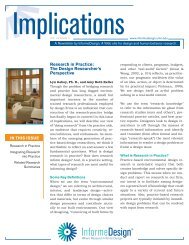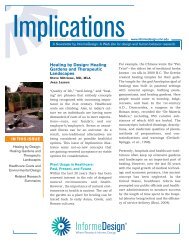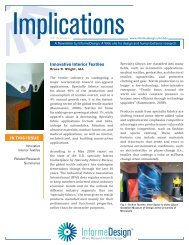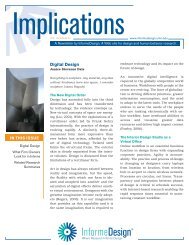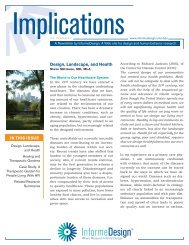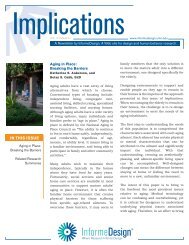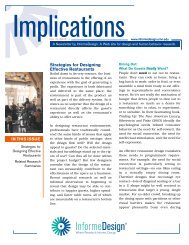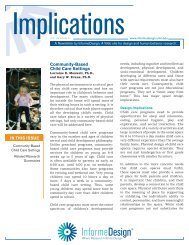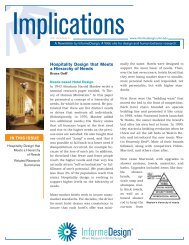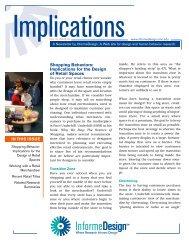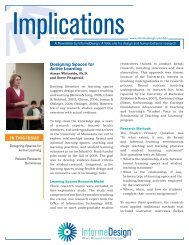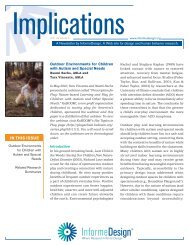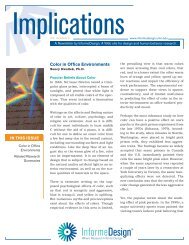Adaptive Reuse for Multifamily Housing: Volume 4 ... - InformeDesign
Adaptive Reuse for Multifamily Housing: Volume 4 ... - InformeDesign
Adaptive Reuse for Multifamily Housing: Volume 4 ... - InformeDesign
Create successful ePaper yourself
Turn your PDF publications into a flip-book with our unique Google optimized e-Paper software.
Implications<br />
www.in<strong>for</strong>medesign.umn.edu<br />
<br />
Standards <strong>for</strong> minimum STC and IIC ratings vary,<br />
with rental properties generally being allowed lower<br />
values than owner-occupied properties. From a marketing<br />
standpoint, though, values above the code requirements<br />
will always be preferable.<br />
Sound isolation is a particular concern in reuse<br />
buildings because the floor and ceiling structure are<br />
already in place and less can be done to attain required<br />
standards. A common solution is to use carpeting<br />
with underlayment pad, but in older buildings<br />
with dense structures this will not be enough;<br />
sounds will “ping through” sometimes a considerable<br />
distance. Additionally, carpet is sometimes not preferred<br />
in structures that have elaborate or decorative<br />
flooring that can be featured as an amenity if left exposed<br />
or <strong>for</strong> indoor air quality reasons. For example,<br />
in a heavy timber structure with hardwood floors, a<br />
designer’s first instinct is to feature both the floor and<br />
ceiling, but this is would likely be an acoustic disaster.<br />
Other common design responses can include additional<br />
insulation, resilient channels, and/or multiple<br />
layers of gypsum board on the ceilings. There are<br />
also a number of products made with recycled rubber<br />
that can be used as sound isolation under new hardsurface<br />
flooring.<br />
Design<br />
There is perhaps no more critical task in adapting a<br />
building <strong>for</strong> multifamily use than to exhaustively understand<br />
the needs and desires of the potential residents.<br />
This is especially important in adaptive reuse<br />
because the pool of buyers or tenants <strong>for</strong> adaptive<br />
structures is much smaller than <strong>for</strong> the larger housing<br />
market. This process typically begins with an<br />
evaluation of the basic programming elements, the<br />
fine-grained market-driven requirements and desires<br />
that any design process accounts <strong>for</strong> (e.g., the number<br />
of bedrooms, the types of amenities).<br />
Key to this process is recognizing the intangible aspects<br />
of an adaptive reuse property and its capacity<br />
to offer more than mere accommodation to potential<br />
residents. This group will not be comparing an<br />
adaptive project to a three-car-garage, mass-market<br />
property in the suburbs. Rather, this population will<br />
be looking <strong>for</strong> a building that reflects their values in<br />
ways that commodity housing can not—from big-picture<br />
ideas to the details and quirks of the particular<br />
structure. They will value reuse as inherently more<br />
sustainable than sprawl.<br />
Amenity or eyesore?<br />
<strong>Adaptive</strong> reuse further differs from a blank-slate design<br />
in how the new use interweaves with the history<br />
embodied in the building. Understanding how<br />
this quality will attract potential residents can be<br />
as simple as understanding whether they will view a<br />
scarred, patched, multicolored “ghosted” floor as an<br />
eyesore or as an intensely interesting record of the<br />
building’s past lives. Either response is valid; what is<br />
critical to the designer is anticipating the reaction by<br />
thoroughly understanding the potential resident.<br />
The quirky nature of reuse and the context of reused<br />
buildings can give the residential units an air of customization<br />
and individuality, though customization<br />
may have only occurred incidentally. The design team<br />
Where Research In<strong>for</strong>ms Design®



